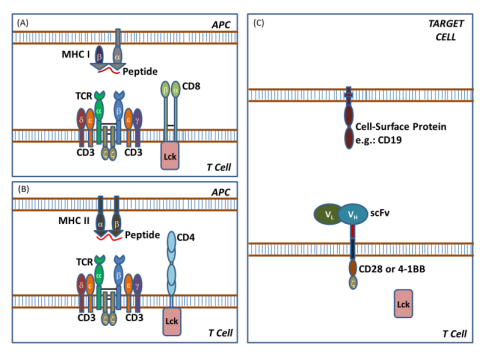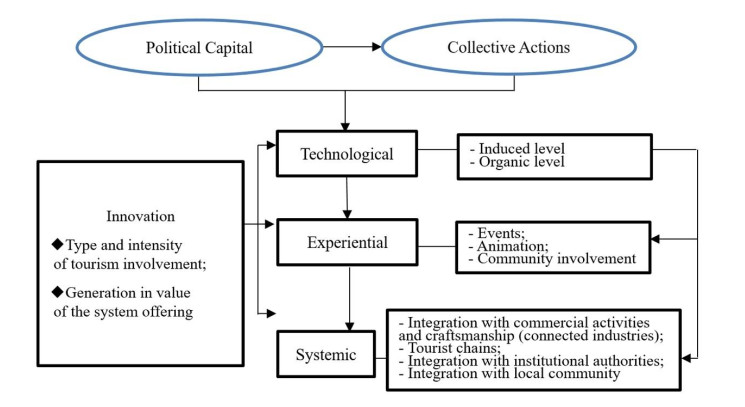1. The Adoptive Cellular Therapy
We are witnessing a rapid advancement in immunotherapy, in particular adoptive T-cell immunotherapy, against specific cancers over the past decade. Currently, adoptive T-cell immunotherapy comprises of three different classes through the use of tumor-infiltrating lymphocytes (TILs), chimeric antigen receptor (CAR)-and T-cell receptor (TCR)-engineered T cells [1]. While TILs are obtained through the isolation from tumor mass, the latter two methods obtain T cells through genetic engineering. Both CAR-and TCR-redirected systems result in the form of antigen-specific T cells, which would permit the immune system to confer an adequate anti-tumor immune response that maybe not present naturally [1].
Several published articles on the distinction between TCR-and CAR-engineered T-cell systems are available (please read review [2] in particular). TCR is an αβ heterodimer receptor, naturally expressed on the T-cell surface, which binds to a specific peptide-major histocompatibility complex/MHC unit. TCR associates with CD3 molecules (γ, δ, ε and ζ chains) to provide intracellular signaling domains, which is a prerequisite for a T cell to confer an immune response. In addition, the presence of either co-receptor CD4 or CD8 supports the responsiveness of a T cell to be activated by TCR binding to as few as one peptide-MHC unit. This sensitive, yet specific system allows T cells to physiologically target intracellular antigens in a form of peptide-MHC complexes [2]. The CAR refers to a synthetic construct typically comprising a single-chain antibody variable fragment, an extracellular domain/hinge, a transmembrane domain, one or more intracellular signaling domains (e.g. CD28 or 4-1BB) and cytoplasmic immunoreceptor tyrosine activation motifs derived from CD3-ζ chain [3]. Less commonly, the CD3-ζ chain is substituted with the γ chain of FcεRI or the CD3-ε chain [4]. The CAR system can target cell surface antigens independent of MHC. Transformed cells, such as cancerous cells, usually express a particular cell surface antigen at high density, hence these kinds of target cells can be recognized and eliminated by the CAR-engineered T cells [2]. Due to the pronounced differences between the CAR and TCR systems (as shown in Figure 1), it is indeed difficult to directly compare these two systems. Nonetheless, it is fair to state that CAR system has more potential to be utilized in a wide population, since it does not face any MHC restriction. On the other hand, TCR is a more specific system than CAR due to its capability to recognize and respond to as few as only one particular peptide-MHC complex [2].
As mentioned above, both CAR and TCR systems are currently being explored as potential treatment targets in different cancers. While the clinical efficacy of CAR-engineered T cells against solid tumors is still limited, partly due to the local immunosuppressive tumor environment, it has been demonstrated that CAR treatment against CD19 antigen (expressed by B cells) resulted in complete remission in several patients suffering from B-cell malignancies [5,6,7,8]. Despite its efficacy, CAR therapy, however, is associated with several side effects. In general, it could cause "the cytokine release syndrome" because of the systemic release of pro-inflammatory cytokines, e.g. TNF-α and IL-6, at high levels [9]. In particular, CD19-specific CAR therapy has been reported to result in B-cell aplasia that prompts for exogenous administration of immunoglobulin [2]. On the other hand, trials using TCR-engineered T cells demonstrated some success in treating both solid and hematological tumors [2]. However, current TCR-engineered T cells have been developed to target tumor-associated antigens (e.g. MAGE-A3 or NY-ESO-1), which are actually self antigens perse [10]. This implies that TCR-generated T cells could cross-react to similar peptide-MHC complexes in heathy tissue, although are presented at very low levels, resulting in severe, sometime lethal adverse events [11,12]. Taken together, despite these two systems are potentially efficacious in treating certain cancers, their safety profiles are still of concern and they need to be addressed and properly rectified before they can be routinely used in the clinical setting.
In addition, due to the complex process to produce a specific type of CAR-or TCR-engineered T cells per patient, there is a cautious remark questioning the ability of patients or public health system to pay substantial costs incurred by these modes of treatment. It is forecasted that the price ranges of CAR-or TCR-engineered T cells are between $120,000 and $300,000 per patient [13,14]. This estimated price seriously challenges the likelihood to implement these modes of treatment in the clinical setting [13]. Therefore, any creative solution to reduce the incurred costs, e.g. converting the engineered T cells from a specific patient-customized item to a mass-produced item [13], will be crucial in order to support and sustain the economic viability of these novel therapeutic modes.
2. The Adoptive T Cells Against Viral Hepatitis
Functional T-cell responses are required to control HBV and HCV replication, as well as to eliminate viral infection [15,16]. Therefore, both CAR and TCR systems have been studied the context of HBV and HCV infection as well. The published viral epitopes, targeted by CAR and TCR-engineered T cells, are summarized in Table 1. With respect to HCV infection, both systems have been extensively studied in vitro, i.e. by targeting HLA-A*02:01-restricted epitopes within HCV NS3 or NS5A protein, as well as HCV E2 glycoprotein in the TCR and CAR systems, respectively [17,18,19,20]. Both systems demonstrated their efficacy in controlling HCV replication in vitro with a low level of cytotoxicity. Nonetheless, subsequent in vivo and clinical studies are required to confirm whether these efficacies observed in vitro can be replicated without a profound risk of morbidity or mortality. Another hindrance is that potent antiviral drugs to cure HCV-infected patients are already available on the market [21], hence questioning the necessity to develop adoptive T-cell immunotherapy against chronic HCV infection.
Table 1. Published HBV and HCV epitopes targeted by CAR-or TCR-engineered T cells.
| System |
HBV |
HCV |
| CAR |
S domain of HBs antigen [22] |
e137 of HCV/E2 glycoprotein [18] |
| TCR |
HLA-A*02:01-restricted HBs183-191 [14,24] |
HLA-A*02:01-restricted NS31073-1081 [17,19,20] |
|
HLA-A*02:01-restricted HBs370-379 [23,24] |
HLA-A*02:01-restricted NS5A1992-2000 [17,20] |
|
HLA-A*02:01-restricted HBc18-27 [23,24] |
|
|
HLA-C*08:01-restricted HBs171-80 [24] |
|
Lack of potent anti-HBV drugs in contrast, has accelerated studies on adoptive T-cell immunotherapy. A research group led by Ulrike Protzer uses CAR that targets HBV envelope protein and has tested this system in a HBV-transgenic mouse model. This group demonstrated that CAR-engineered T cells were able to control HBV replication with a transient liver damage in vivo. In addition, their study showed that the presence of HBs antigens in murine sera did not interfere with the functionality of HBV-specific CAR-engineered T cells [22]. However, it is noteworthy that the levels of HBs antigen in murine sera (~1,000–1,200 IU/mL) correspond only to the levels observed in the low-replicate phase of chronic Hepatitis B [22]. This implies that it is elusive yet on whether CAR-engineered T cells can be functional in patients with higher levels of HBs antigen. As an alternative, the HBV-specific TCR-engineered T-cell research, led primarily by Antonio Bertoletti's group, is focusing on targeting certain MHC-restricted epitopes within viral antigens, e.g. HBV surface or core antigen. This group has demonstrated that TCR-engineered T cells are also able to control HBV replication in both cell lines and xenograft mice [14,23].
Taken together, both CAR-and TCR-engineered T cells have merits to be further developed as a potential treatment tool against chronic HBV infection. However, both methods are associated with a risk of significant liver inflammation and consequently, liver damage. Therefore, extensive studies are required to provide sufficient evidence in order to support the efficacy and safety of these treatment modes for patients with chronic HBV infection.
3. The Adoptive T Cells Against Viral Hepatitis-associated Liver Cancer
It has been acknowledged that chronic viral hepatitis contributes to the majority of primary hepatocellular carcinoma/HCC cases [25]. In line with the primary usage of adoptive T-cell therapy against cancers, this mode of treatment has a potential utility for the treatment of HBV-or HCV-associated HCC.
It is important to point out that a high frequency of HBV DNA integration is observed in the genome of HBV-associated HCC cells, resulting in the expression of HBV antigens by tumor cells [26]. This allows the usage of TCR-engineered T cells to treat HBV-associated HCC. Unlike self antigens, HBV antigens are not found in healthy tissues. Hence, these viral antigens theoretically can serve as better target antigens in certain HCC cases. However, since non-cancerous but HBV-infected hepatocytes also express HBV antigens, HBV-specific TCR-engineered T cells could attack those infected hepatocytes. This potentially could cause severe liver damage.
To address this concern, Bertoletti's group decided to treat a liver-transplanted patient who developed extrahepatic HCC metastasis with HBV-DNA integration, as the first use of HBV-specific TCR-engineered T cells in a clinical setting [27]. The patient importantly exhibited HBV surface antigen restricted by HLA-A*02:01 (i.e., HBs183-191 epitope), only in tissues with the extrahepatic HCC metastasis. Hence, the metastatic tissue could be attacked by HBV-specific TCR-engineered T cells with a significant reduced risk of damaging healthy liver tissue. Indeed, this group demonstrated the clinical potential and safety of using HBV-specific TCR-engineered T cells by choosing a suitable patient [27]. This finding still needs to be validated in clinical studies using large number of patients. Nonetheless, this milestone study suggests that the adoptive T-cell therapy can be used against a selected group of HBV-associated HCC cases, such as to prevent or treat HCC recurrence in liver-transplanted patients with HBV-positive HCC [28]. In addition, this research group recently modified its TCR engineering technology from the viral vector-based to mRNA electroporation-based method [14]. This TCR mRNA electroporation method is, arguably, a promising technology [14] due to its successful rate of engineering T cells (approximately half of the engineered T cells were endowed with antigen-specific functionality), its better safety profile (because of the transient functionality of engineered T cells) and its much reduced costs (approximately $30,000 per patient because of the less complexity and effort to engineer T cells). This improved technology, if proven, would sustain the economic viability of developing and implementing HBV-specific TCR-engineered T cells for clinical use.
In contrast, HCV as an RNA virus does not integrate with the host genome. Therefore, despite a study demonstrated the utilization of HCV-specific TCR-engineered T cells against HCV-associated HCC in cell lines and xenograft mice [29], it will be difficult to select a suitable group of HCV-associated HCC patients in order to be treated with this treatment mode.
4. Concluding Remark
We are entering a new exciting era where adoptive T-cell immunotherapy is extensively studied against viral hepatitis-associated liver cancer. Based on the evidence presented in this review, we are optimistic and feel that the adoptive T-cell immunotherapy, at least in a form of TCR-engineered T cells, could serve as a novel alternative yet effective treatment for a selected group of HBV-associated HCC patients.
Acknowledgment
No fund or grant was received for this article.
Conflict of Interest
Both authors are also employees of Nutricia Research and therefore declare potential conflicts of interest.










 DownLoad:
DownLoad: 


